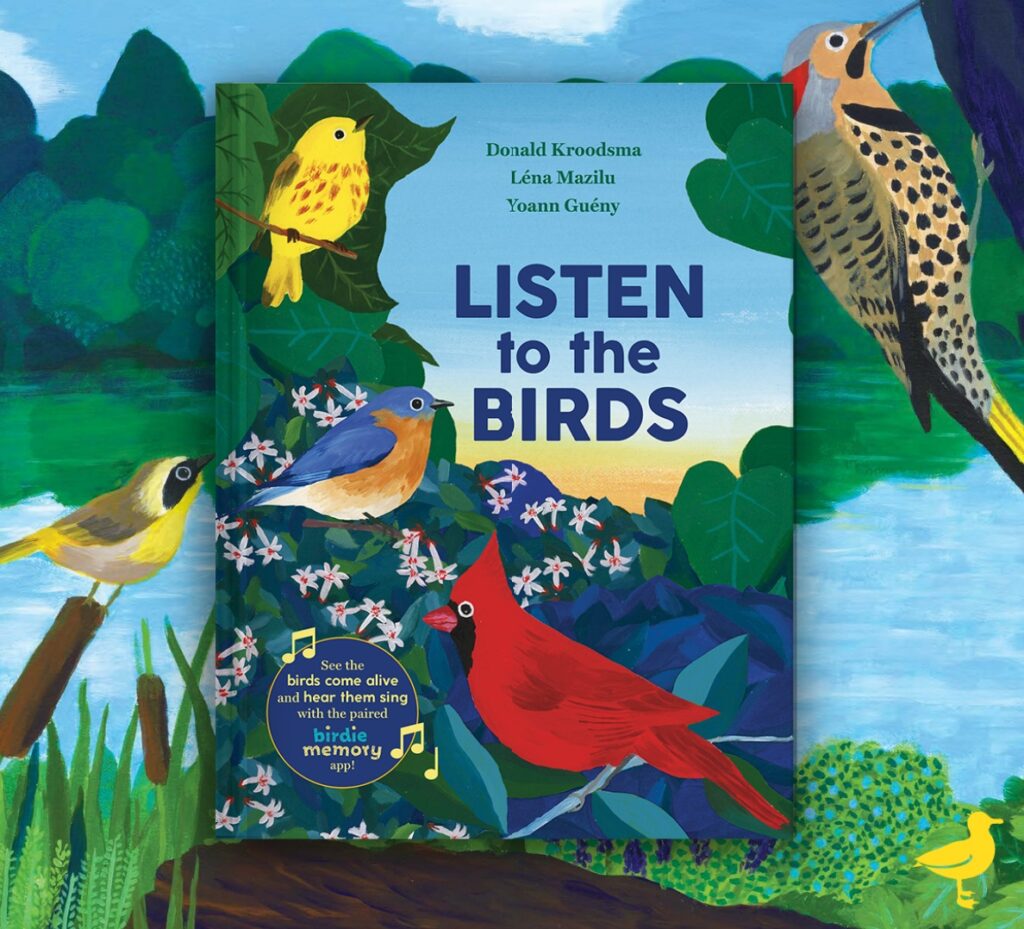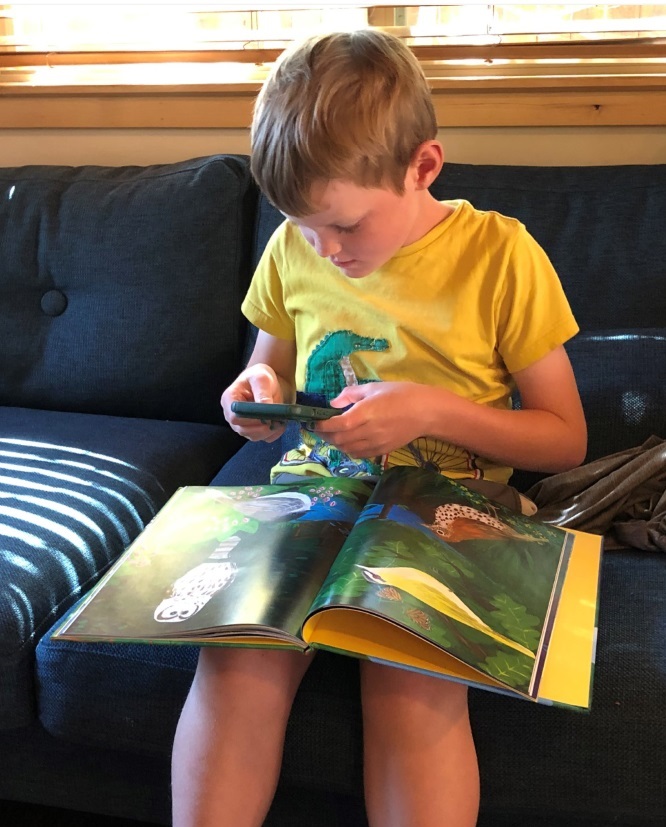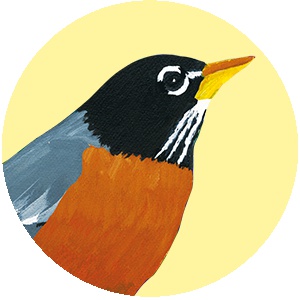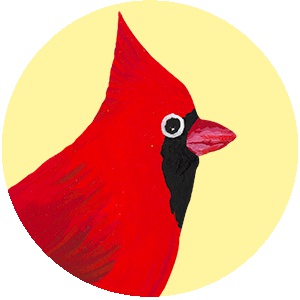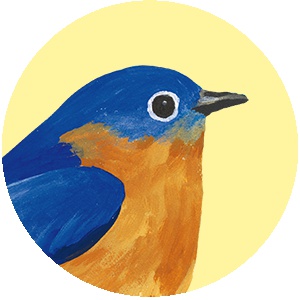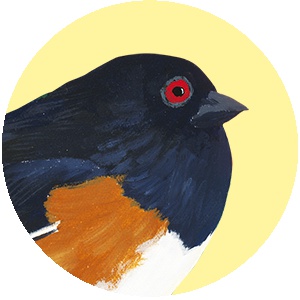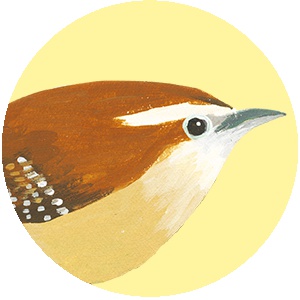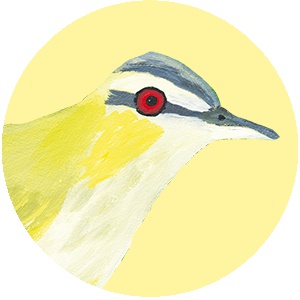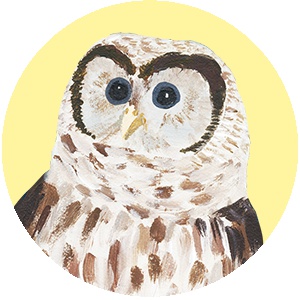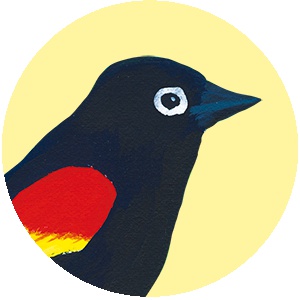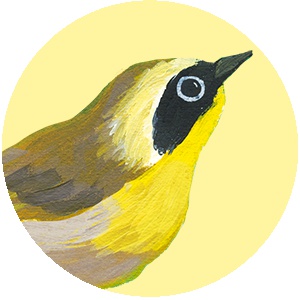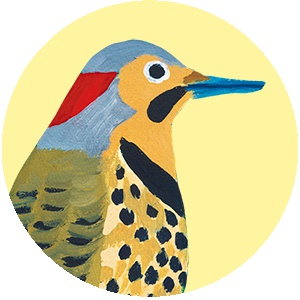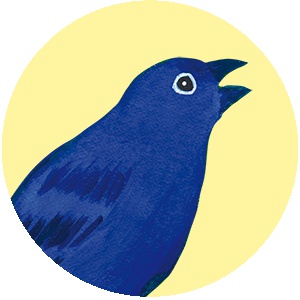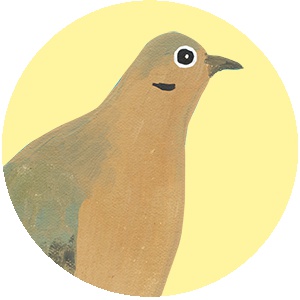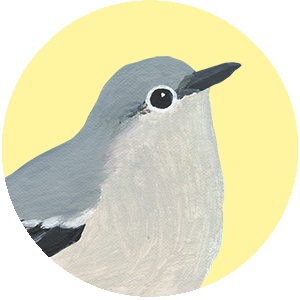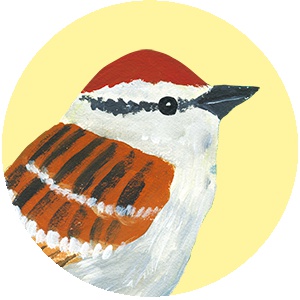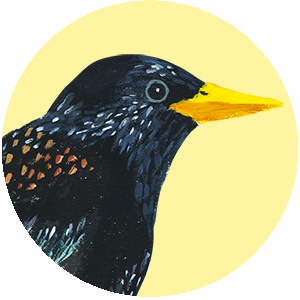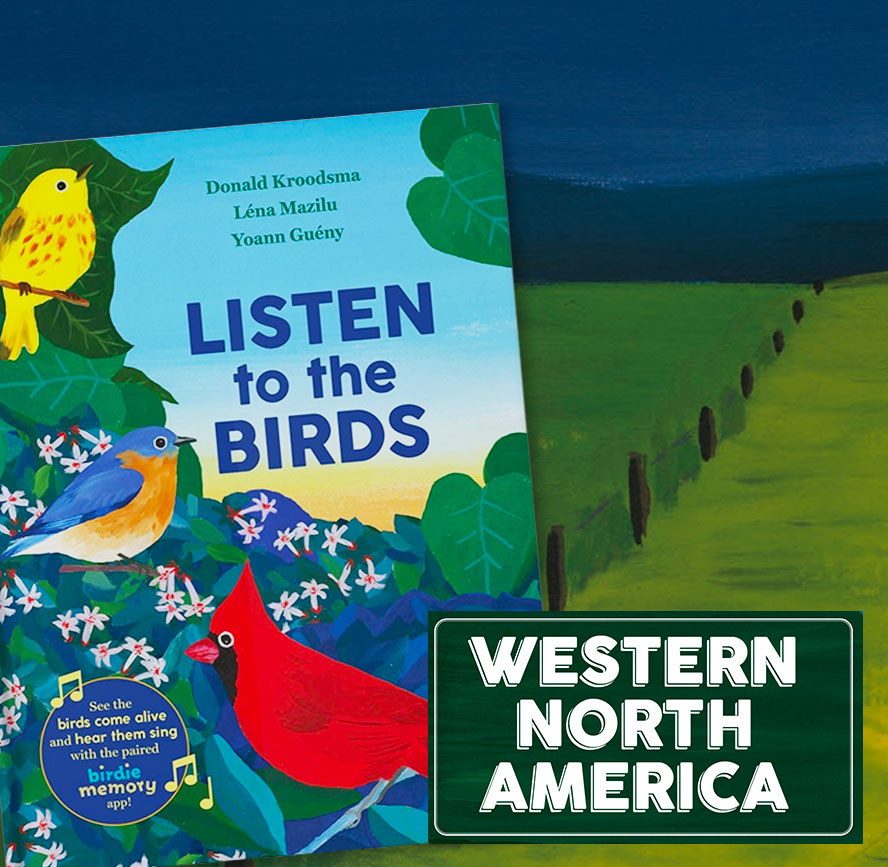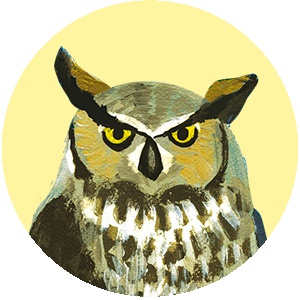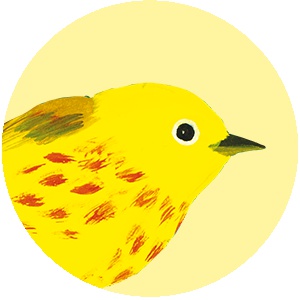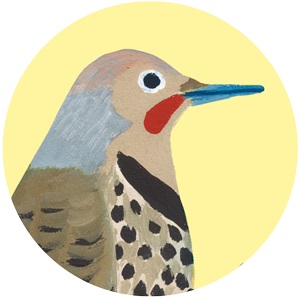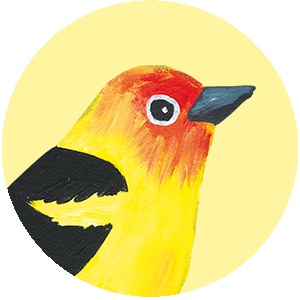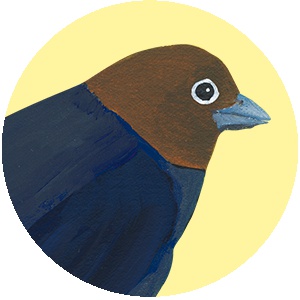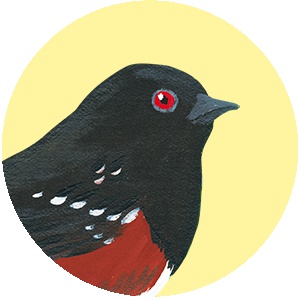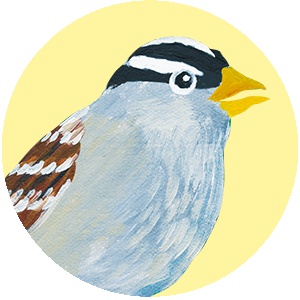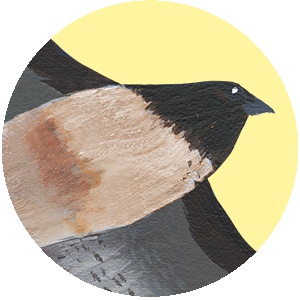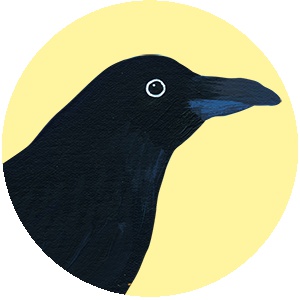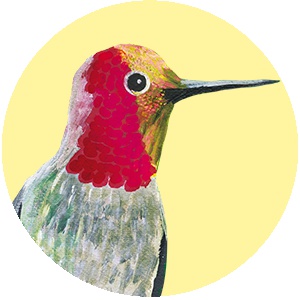SEE THE PRESS RELEASE for LISTEN TO THE BIRDS
HERE’S A TRAILER that shows how the birds in the book come alive and sing! Or try this BRIEF VIDEO that shows more (be sure to unmute the speaker).
WHAT PEOPLE ARE SAYING (e.g., excerpts from Amazon reviews)
- The artwork: “ . . .gorgeous, richly-colored portrayals of the thirty-five North American birds . . .” (Right: an enthralled 7-year-old)
- The plan: “The [35] species are presented as we might find them on a couple of imaginary walks (one in the East, one in the West).”
- The text: The book is “ . . . enriched by the author’s enthusiasm and expertise. It is as if he were holding your child’s hand and sharing his sense of wonder.” . . . “The text is interesting and super-informative (unsurprising, as author Kroodsma probably knows more about birdsong than anyone else on Earth).” . . . “Reading this book is like taking nature walks with a wise and patient guide.”
- The Magic of augmented reality: Aim your phone or tablet’s camera “at any of the bird pictures in the book and, like magic, a snippet of the bird’s singing plays [and the bird itself is animated, even blinking its eyes].” . . . “Dad, this is literally the coolest thing I have ever seen!”
- A book for whom? “It is a unique, beautiful book which can be enjoyed by all ages.” . . . “A treasure . . .” “ . . . my kindergarten students love it!” . . . “my 7 and 9-year old grandsons . . . had great fun listening to the songs then quizzing each other.” . . . “my 26 month old grandson found it fascinating. His 3rd grade brother took it levels higher . . . [they] couldn’t get enough of this book.” . . . “My granddaughter, almost four, had a major exclamation of joy when the first bird moved under the application and sang.” . . . “I gave one to my daughter that she can enjoy and show her college buddies.” . . . “the kids seem mesmerized by your book. Like a magic trick to figure out.” . . . “there is plenty to keep your kids looking and listening and learning and laughing as they walk through the book over and over.” . . . .”I love this book, and wish I had owned it seventy five years ago.”
- Irresistible nature of the book: “I was so taken with this book that I bought 10 more copies to give to friends. The book is that good.”
- A Warning. “If you get this book for your child you might soon be asked to buy a more comprehensive adult field guide to birds and binoculars. Furthermore, you might not be able to use a television or computer as a baby-sitter as your child asks to go outside and encounter the living birds.”
- Summary: “. . . animation (‘augmented reality’, of all things!), vibrant colors, fine sounds, charismatic birds, and a text all combined to take the child of any age into nature on a journey of wonder.”
For anyone who loves birdsong, says the American Birding Association:
- Read the review by the American Birding Association: ” . . . elicited a true shout of joy . . .”
- Listen to Rebecca Minardi of the American Birding Association review the book ” . . . blew me away . . .”
MORE BIRD SONG!
(to supplement the text and songs in the book)
All sounds recorded by Donald Kroodsma
THE PARK ON THE EDGE OF TOWN
American Robin: Daytime singing. During the day, the robin sings several carols and then pauses before singing more carols. (Early April 2004, at the Quabbin Reservoir, western Massachusetts.)
American Robin: Dawn singing. Here is the same robin at dawn, now singing rapidly with his low carols and his high squeaky notes. (Early April 2004, at the Quabbin Reservoir, western Massachusetts.)
Northern Cardinal: The female sings too! Here are four examples of the female singing from the nest; in each example, her mate first sings in the distance, and then she answers from the nest, replying with the same song that he just sang. (During May 2018, near my home in Hatfield, Massachusetts.)
Northern Cardinal: “Eventual variety.” Cardinals sing with eventual variety; in this shortened example, hear 3 songs of one kind, then 3 of another, 3 of another, and 3 of another, for a total of 12 songs. (May 28, 2010, in a town park in Grundy, Virginia.)
Northern Cardinal: Slow those whistles down! What fun to listen to songs when they are slowed down; here is one example of each of those four different songs. If you are a good whistler, you can whistle some of the cardinal’s songs. (May 28, 2010, from the town park in Grundy, Virginia.)
Northern Cardinal: Seven minutes with a cardinal. Here’s a more realistic sequence from a male cardinal, who sings eight different songs over eight minutes. Can you hear when he switches songs? (June 6, 2006, in a cemetery near my home in Hatfield, Massachusetts.)
Tufted Titmouse: Two different songs from a male. Listen for five of one song, then five of another. They sound like peter-peter songs, don’t they. (May 1, 2012, near Story, Indiana.)
Tufted Titmouse: Song variety and song matching! Not all songs are of the peter-peter variety. Here’s a different one. Do you hear how the male in the background matches the song of the male in the foreground? (May 15, 2010, at the Yorktown National Battlefield, Yorktown, Virginia.)
Blue Jay: Many different sounds. What a wonderful variety of JAY calls these birds can make; last in this selection are some “squeaky gate” calls. (Early May, 2004, on the Norwottuck Rail Trail, Amherst, Massachusetts.)
Blue Jay: Call matching. Jays often match each other with their different calls. Here, the nearby bird calls just like the jays in the background. Then they all switch to a new call after about 12 seconds. (April 21, 2003, outside my bedroom window in Amherst, Massachusetts.)
EDGE HABITAT
Eastern Bluebird: Daytime singing. Here is the gentle pace of daytime singing. He sings a number of different songs here, not alternating just two like he often does. (April 16, 2001, on the Cherry Hill golf course, Amherst, Massachusetts.)
Eastern Bluebird: Dawn singing. At dawn, he uses the same songs, but he adds a chatter before most songs. (June 6, 2006, on the Cherry Hill golf course, Amherst, Massachusetts.)
Eastern Towhee: Daytime singing. During the day, he sings one of his songs many times before switching to another. Here are just five examples of one of his songs. (May 22, 2010, Tye River Gap, Blue Ridge Parkway, Virginia.)
Eastern Towhee: Dawn singing. He dazzles at dawn, rarely singing the same song back-to-back. Just listen to the variety of songs! Sometimes we listen to the same bird for a long time, to get to know him. Here’s your chance, for over six minutes. Do you hear the Mourning Dove in the background? Other birds are singing, too. (June 1, 2010, Mammoth Cave National Park, Kentucky.)
Carolina Wren: She calls when he sings. When awaking from her night’s roost, she responds to her mate’s three songs. (October 16, 2003, Corkscrew Swamp Sanctuary, Naples, Florida.)
Carolina Wren: Great variety in his songs. Here are eight different songs from a male; remember, though, that he sings with eventual variety, so you’d never hear him sing just one example of a given song like this. Isn’t the variety pleasant! (October 16, 2003, Audubon’s Corkscrew Swamp Sanctuary, Naples, Florida.)
Carolina Wren: Eventual variety during relaxed daytime singing. During the daytime, it seems that he can sing the same song forever, sometimes hundreds of times. Here are 60 songs, all of the same kind! (May 4, 2012, Honker Lake, Land Between the Lakes, Kentucky.)
Carolina Wren: Excited dawn singing. What fun listening to an excited Carolina Wren before sunrise. He introduces new songs frequently, and often alternates two different songs. (May 16, 2010, Yorktown National Battlefield, Yorktown, Virginia.)
FOREST
Red-eyed Vireo: Try the vireo challenge! Hear that unique song at 8 seconds? When does he sing it again? Can you pick out other unique songs and listen for them to occur again? (July 3, 1995, Savoy Mountain State Forest, Berkshire Mountains, Massachusetts.)
Red-eyed Vireo: He often sings for hours at a time. What fun to listen to the vireo sing, and he often does sing from the treetops for hours and hours! There’s a wonderful variety of vireo songs in these seven minutes. (May 21, 2012, Quabbin Park, Ware, Massachusetts.)
Wood Thrush: Just listen! One of the most special eastern singers; here are 43 songs in a little over two minutes. (May 3, 2002, in the woods beside my home in Amherst, Massachusetts.)
Wood Thrush: Slowed down so we hear the details. Birds have better ears than we do, and when we slow the songs down, we are hearing more of the details that the birds themselves hear. Besides, the songs are really beautiful when slowed down four times, as we’ve done here! (May 3, 2002, in the woods beside my home in Amherst, Massachusetts.)
Wood Thrush: Even more details! Doesn’t he sound like a very large bird when we slow the songs down eight times? Like a big whale! What fun! (May 3, 2002, in the woods beside my home in Amherst, Massachusetts.)
Eastern Phoebe: Excited dawn singing. At dawn, he excitedly alternates his fee-bee and fee-b-brre-be songs. (June 2, 2008, Prairie State Park, Mindenmines, Missouri.)
Eastern Phoebe: Less energized daytime singing. Later in the day, he usually sings several fee-bee songs before offering a single fee-b-brre-be. (March 29, 2012, Rattlesnake Gutter, Leverett, Massachusetts.)
Barred Owl: Hair raising sounds. In the dark night, listening to these owls will make your hair stand on end! Who-who-who-who-who-whoall is the most common variation here. (May 5, 2001, Lawrence Swamp, Amherst, Massachusetts.)
Barred Owl: Male and female! Two owls. One begins with the standard Who-cooks-for-you, who-cooks-for-youall. But listen to what happens next! (July 13, 2015, Cricket Hill, Conway, Massachusetts.)
Barred Owl: And more! More hair-raising interactions between the male and female. (May 31, 2012, Notchview Reservation, Windsor, Massachusetts.)
POND
Red-winged Blackbird: Daytime singing. When relaxed during the day, he sings one of his songs many times before switching to another. Here are just five songs, all the same kind. (May 4, 2017, Bass Lake, Atlanta, Michigan.)
Red-winged Blackbird: Female calls when male sings. Five times the male sings, and each time the female answers him with her ch-ch-ch-chit call. (May 4, 2017, Bass Lake, Atlanta, Michigan.)
Common Yellowthroat: Wichity songs. Four wichity songs from a male. (May 17, 2012, Satan’s Kingdom Wildlife Management Area, Northfield, Massachusetts.)
Common Yellowthroat: Another version of the wichity song. Four wichity songs from another male. It’s still wichity, but with a little different accent. (May 28, 20215, East Leverett Meadow, Leverett, Massachusetts.)
Northern Flicker: Drumming, singing. Three drums and a song, accompanied by a Spotted Towhee. (March 7, 2017, Montaña de Oro State Park, Los Osos, California.)
Northern Flicker: Song, flicka calls, and a drum. A distant song with loud flicka calls, followed by a drum; flickers make quite a variety of sounds. In the background, can you pick out the Mourning Dove? (June 4, 2008, Quivira National Wildlife Refuge, Stafford, Kansas.)
MORE EDGE HABITAT
Indigo Bunting: Neighbors learn from each other. Neighbors usually learn each other’s songs, but the songs can vary so much in different neighborhoods. Here is one song from each of two neighbors. Listen again and again and you’ll feel how similar they are to each other. (June 5, 2006, Quabbin Park, Ware, Massachusetts.)
Indigo Bunting: Song learning, example 2. Here are two other neighbors. (May 22, 2010, Tye River Gap, Blue Ridge Parkway, Virginia.)
Indigo Bunting: Song learning, example 3. And still two other neighbors. (May 11, 2014, Francis Marion National Forest, South Carolina.)
Mourning Dove: Whistling wings. Hear his whistling wings when he lands and then takes flight again. A loud Spotted Towhee sings along, with a few extra drink notes before his teeeeeeee. (June 8, 2008, Temple Canyon Park, Cañon City, Colorado.)
Mourning Dove: Singing before sunrise. Listen to all the Mourning Doves here, all singing half an hour before the sun rises. (April 30, 2018, Atlanta, Michigan.)
Northern Mockingbird: Mimicry. For those of us who love mockingbirds, we can’t get enough of listening to them. So we give you here over seven minutes of good listening. And if you listen really carefully, perhaps you’ll hear this mockingbird mimic several of the birds you know: Northern Flicker, Blue Jay, Common Yellowthroat, Carolina Wren, Eastern Bluebird, Wood Thrush, Tufted Titmouse, Eastern Phoebe, and House Finch. (May 6, 2004, Willis Church, Glendale, Virginia.)
Northern Mockingbird: More mimicry. Here are another seven minutes from another singer. Do you hear him mimic American Robins, Northern Cardinals, Northern Flickers, and Blue Jays? (May 19, 2010, Lake Anna State Park, Spotsylvania, Virginia.)
BACK TO THE PARK
Chipping Sparrow: Song learning. Here are the songs of two neighbors who have learned the same song. They sound the same, don’t they? (May 3, 2015, Garland Lodge and Golf Resort, Lewiston, Michigan.)
Chipping Sparrow: More song learning. Here are two more neighbors who have learned an entirely different song from the first example. (May 5, 2015, Look Park, Northampton, Massachusetts.)
Chipping Sparrow: Just one song for each male. Each male sings his only song over and over. Here are just five songs from one male. (May 3, 2015, Garland Lodge and Golf Resort, Lewiston, Michigan.)
European Starling: Special mimicry. In this 50-second song of an eastern starling, you can hear that special section at 13-17 seconds where he simultaneously mimics an Eastern Phoebe and Northern Flicker. (April 30, 2014, Atlanta, Michigan.)
European Starling: A western singer. Western starlings mimic western songs, but this one doesn’t mimic any of the songs on our walks. At 16 seconds, maybe you hear the frog he’s mimicked? (June 10, 2009, Malheur National Wildlife Refuge, Burns, Oregon.)
House Finch: Typical songs. Four songs that are bright, rollicking, cheery, and just a little hoarse. (May 23, 2004, downtown Sebree, Kentucky.)
House Finch: Excited dawn singing. He sounds a lot more excited to sing at dawn. (March 24, 2017, Anza-Borrego Desert State Park, California.)
House Finch: Courting a female. When he’s trying to impress a female, just listen to all those high-pitched calls he inserts into his songs! (June 18, 2006, cemetery near my home in Hatfield, Massachusetts.)
TOWN PARK
Great Horned Owl: Almost always heard in the distance. When we hear owls, they’re usually distant, and we can barely hear them. With a chorus of songbirds here (American Robins and Black-headed Grosbeaks), we hear the male and female owl duet twice, and then the female calls two more times. (May 24, 2009, William L. Finley National Wildlife Refuge, Corvallis, Oregon.)
Western Wood-pewee: Daytime bzeeyeer. During the daytime, it’s the burry bzeeyeer that he repeats over and over, at a leisurely pace. Listen closely and you may hear a Western Tanager and House Wren, maybe even an American Robin. (June 14, 2009, William L. Finley National Wildlife Refuge, Corvallis, Oregon.)
Western Wood-pewee: Energized dawn singing. During rapid dawn singing, he alternates his two songs, bzeeyeer, tswee-tee-teet. (June 14, 2009, William L. Finley National Wildlife Refuge, Corvallis, Oregon.)
Western Wood-pewee: More energized dawn singing. Can’t get enough dawn singing from this pewee? Here are over six minutes! Before sunrise, he sings like this every morning during the spring and summer, when most humans are still sleeping. (June 14, 2009, William L. Finley National Wildlife Refuge, Corvallis, Oregon.)
American Robin: Daytime singing. During the day, the robin sings several carols and then pauses before singing more carols. (Early April 2004, at the Quabbin Reservoir, western Massachusetts.)
American Robin: Dawn singing. Here is the same robin at dawn, now singing rapidly with his low carols and his high squeaky notes. (Early April 2004, at the Quabbin Reservoir, western Massachusetts.)
Yellow Warbler: Daytime singing. During the day, he repeats one of his songs over and over, just five times here. (June 9, 2012, Parker River Natinal Wildlife Refuge, Newburyport, Massachusetts.)
Yellow Warbler: Excited dawn singing. Before sunrise, oh, just listen to all the different songs and the excited chipping between songs. In half a minute, he sings eight different songs, with immediate variety! (May 30, 2009, Lava Hot Springs, Idaho.)
Yellow Warbler: More dawn singing. For 45 minutes a Yellow Warbler sings his excited dawn chorus; if you can’t get enough of it, here are nearly a dozen minutes! Just imagine waking up and singing like this for 45 minutes every morning. (May 30, 2009, Lava Hot Springs, Idaho.)
SCRUBBY BRUSH
House Wren: Six songs, all alike. This House Wren offers six songs, all sounding the same. (June 15, 2008, Mt. Princeton, Colorado.)
House Wren: He sings with eventual variety. Here are another six songs from another male. The males in these two examples are highly repetitive, singing the same song over and over; eventually each would switch to another of his many songs. (June 15, 2009, William L. Finley National Wildlife Refuge, Corvallis, Oregon.)
Mourning Dove: Whistling wings. Hear his whistling wings when he lands and then takes flight again. A loud Spotted Towhee sings along, with a few extra drink notes before his teeeeeeee. (June 8, 2008, Temple Canyon Park, Cañon City, Colorado.)
Mourning Dove: Singing before sunrise. Listen to all the Mourning Doves here, all singing half an hour before the sun rises. (April 30, 2018, Atlanta, Michigan.)
Northern Flicker: Drumming, singing. Three drums and a song, accompanied by a Spotted Towhee. (March 7, 2017, Montaña de Oro State Park, Los Osos, California.)
Northern Flicker: Song, flicka calls, and a drum. A distant song with loud flicka calls, followed by a drum; flickers make quite a variety of sounds. In the background, can you pick out the Mourning Dove? (June 4, 2008, Quivira National Wildlife Refuge, Stafford, Kansas.)
FOREST
Black-headed Grosbeak: Daytime brilliance. His daytime singing is brilliant and bold, with pauses between songs. (June 8, 2008, Temple Canyon Park, Cañon City, Colorado.)
Black-headed Grosbeak: Dawn superlatives! At dawn the effect is breathtaking; hear how he sings more slowly, so beautifully. (June 8, 2008, Temple Canyon Park, Cañon City, Colorado.)
Black-headed Grosbeak: More dawn singing. It’s not easy to stop listening to a dawn-singing Black-headed Grosbeak after only half a minute. Here are ten and a half minutes! (June 8, 2008, Temple Canyon Park, Cañon City, Colorado.)
Western Tanager: Daytime singing. During the daytime, he sings a compact song with long pauses between songs. Do you hear another Western Tanager in the background? (May 26, 2009, Prairie City, Oregon.)
Western Tanager: Dawn singing. At dawn, he sings more slowly, spacing out the individual phrases, and he includes his pit-er-ick call. (June 13, 2009, Malheur National Wildlife Refuge, Burns, Oregon.)
Brown-headed Cowbird: Singing in a flock. A variety of songs from seven males, just overhead. (May 29, 2010, Redbird Wildlife Management Area, Daniel Boone National Forest, Big Creek, Kentucky.)
Brown-headed Cowbird: Relishing the details. Three of those songs at normal speed, then slowed down four times. You can begin to hear the details now; hear how he begins low with his left voice box, then leaps high with his right. (May 29, 2010, Redbird Wildlife Management Area, Daniel Boone National Forest, Big Creek, Kentucky.)
Brown-headed Cowbird: Spring song by a flock of males. In early spring, sometimes cowbirds gather in a flock, all of them singing. It’s special. (March 20, 2017, Los Osos, California.)
Brown-headed Cowbird: Songs of the flock slowed down. Even more special is to slow all of those cowbirds down four times so that we can better hear what they are singing! (March 20, 2017, Los Osos, California.)
Hermit Thrush: Just listen! Sometimes we listen for a long time to such a beautiful singer! Can you hear how he has about 10 different songs? (June 13, 2006, Quabbin Park, Ware, Massachusetts.)
Hermit Thrush: Example 2. Here’s another example, from Arizona. (May 12, 2016, Arcadia Campground, Mt. Graham, Arizona.)
STREAM AND WILLOWS
Spotted Towhee: Relaxed daytime singing. During the day, he often sings the same song for 10 or 20 minutes. (June 1, 2018, William L. Finley National Wildlife Refuge, Corvallis, Oregon.)
Spotted Towhee: Excited dawn singing. He reveals his songs much more rapidly at dawn. Do you hear three different songs in this sequence? (May 23, 2009, William L. Finley National Wildlife Refuge, Corvallis, Oregon.)
White-crowned Sparrow: Songs of a dialect. Here is one song from each of three birds in the same California dialect. (March 14, 2017, Harmony Headlands State Park, Cayucos, California.)
White-crowned Sparrow: Songs of a second dialect. Here are three males from another dialect. Hear how different this dialect is from the first? (June 3, 2009, Red Rock Lakes National Wildlife Refuge, Lima, Montana.)
Red-winged Blackbird: Daytime singing. When relaxed during the day, he sings one of his songs many times before switching to another. Here are just five songs, all the same kind. (May 4, 2017, Bass Lake, Atlanta, Michigan.)
Red-winged Blackbird: Female calls when male sings. Five times the male sings, and each time the female answers him with her ch-ch-ch-chit call. (May 4, 2017, Bass Lake, Atlanta, Michigan.)
Barn Swallow: Near the barn. It’s a jumbled, bubbling song—he sings near the barn! Let’s let him sing for a while. (July 5, 2012, Whately, Massachusetts.)
Barn Swallow: Slow him down and hear the details. Let’s slow him down to half speed; we now hear more details. Another bird sings at the same time (a Song Sparrow), but you can sort out the Barn Swallow. (July 5, 2012, Whately, Massachusetts.)
MEADOW
Red-tailed Hawk: Kee-eeee-arrr. Soaring over the meadow, the red-tail calls kee-eeee-arrr, at it’s usual leisurely pace. Watch him, wait for the next call. (May 24, 2009, William L. Finley National Wildlife Refuge, Corvallis, Oregon.)
Red-tailed Hawk: Kee-eeee-arrr, example 2. The kee-eeee-arrr here feels shortened from this perched bird. The hawk might be upset that we are too close to its nest. (June 11, 2018, Carmen Valley, Plumas County, California.)
Western Meadowlark: Eventual variety. How beautifully he sings, with eventual variety. Can you detect when he changes from one song to another? (June 3, 2009, Red Rock Lakes National Wildlife Refuge, Lima, Montana.)
Western Meadowlark: A male’s song repertoire. This male knows 13 different songs; listen here to 2 examples of each, for a total of 26 songs. (June 10, 2018, Sierra Valley, California.)
Common Raven: Call matching. First one raven calls, then another joins, the two of them using the same croak. After about 50 seconds, they change to another of their calls. What fun listening to two intelligent creatures talking to each other! (June 6, 2009, Big Hole Natinal Battlefield, Wisdom, Montana.)
Common Raven: Call matching, example 2. Another example of “call matching” by two ravens. (May 5, 2016, Portal, Arizona.)
TOWN PARK AGAIN
House Finch: Typical songs. Four songs that are bright, rollicking, cheery, and just a little hoarse. (May 23, 2004, downtown Sebree, Kentucky.)
House Finch: Excited dawn singing. He sounds a lot more excited to sing at dawn. (March 24, 2017, Anza-Borrego Desert State Park, California.)
House Finch: Courting a female. When he’s trying to impress a female, just listen to all those high-pitched calls he inserts into his songs! (June 18, 2006, cemetery near my home in Hatfield, Massachusetts.)
Anna’s Hummingbird: His scratchy songs. Listen to several of his songs excerpted from an all-day recording. (March 19, 2017, Montaña de Oro State Park, Los Osos, California.)
Anna’s Hummingbird: His scratchy songs, slowed down. His songs are so high-pitched that we can’t appreciate all that he does. Here is one of his songs slowed down 2 times, then 4 times, then 8 times. It gives you an all new appreciation for what he sings and hears! (March 19, 2017, Montaña de Oro State Park, Los Osos, California.)
